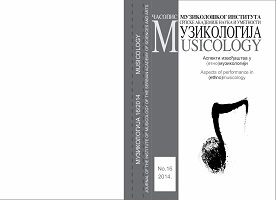Музичко пројектовање нације: етносимболизам Мокрањчевих руковети
Musical Shaping of the Nation: Ethno-Symbolism of Mokranjac’s Garlands
Author(s): Biljana MilanovićSubject(s): Customs / Folklore, Music, Cultural Anthropology / Ethnology, Culture and social structure , Sociology of Art, History of Art
Published by: Muzikološki institut SANU
Keywords: Stevan Stojanović Mokranjac; handles; ethnosymbolism; nation; tradition;
Summary/Abstract: This article deals with Stevan Mokranjac’s fifthteen garlands (rukoveti), which are commonly regarded as the national project in Serbian art music that was accomplished through the producing of the tradition of the Serbian folk song. The garlands are examined by employing the concept of ethno-symbolism, theoretically associated with Anthony Smith. The elements of ethno-symbolism, and especially those aspects of this theory through which the articulation of a national identity activates connections with pre-modern myths, recollections and collective symbols, have proven useful in contextualization of folk material and its ethnological environment, with which the art work establishes intertextual connections. With his project Mokranjac created a rich network of ethno-symbols associated with the themes and motives of both rural and semi-urban communities that were characterized by their preservation of the model of patriarchal culture. Their strong attachment to ‘ethno-history’ as well as ‘symbolic geography’ produced various ‘ethno-scapes’, which established an increasingly symbiotic context of a ‘naturalized’ community and ‘historicized’ nature and territory. Mokranjac presented them as a representative sample in the process of legitimizing national consolidation and homogenization through the folk song. These aspects are observed in both textual and musical dimensions of Mokranjac’s garlands. The connection between his fieldwork and his compositions is also problematized. Mokranjac’s garlands are distinguished by their inclusiveness and a constant blending of older and newer ethno-historical elements, with an aim of constructing a unique tradition of national song, as an integral time-and-space image of the nation. Through this dimension of collectivism we can observe Mokranjac’s close connection to the patriarchal culture, as it remained an important ethno-symbolist element in both the politics and the poetics of his artistic project. At the same time, it provided a platform for free invention when it came to the more advanced stages of composition, when the patriarchal culture would be subjected to transfiguration by his individual creative imperatives. Mokranjac’s Garlands were the first works in Serbian music to emerge as results of an aesthetically rounded and ideologically grounded compositional project, which facilitated their canonization within the framework of Serbian art music.
Journal: Muzikologija
- Issue Year: 1/2014
- Issue No: 16
- Page Range: 211-226
- Page Count: 16
- Language: Serbian

